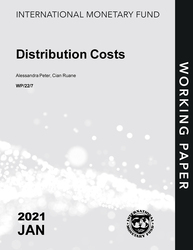
Distribution Costs
Distribution Costs
READ MORE...
Volume/Issue:
Volume 2022
Issue 007
Publication date: January 2022
ISBN: 9781616355036
$5.00
Add to Cart by clicking price of the language and format you'd like to purchase
Available Languages and Formats
| English |
Prices in red indicate formats that are not yet available but are forthcoming.
Topics covered in this book
This title contains information about the following subjects.
Click on a subject if you would like to see other titles with the same subjects.
Labor , Economics- Macroeconomics , Economics / General , Industries - Manufacturing , Distribution , transportation costs , aggregate productivity , welfare loss , distribution sector , distribution share , share of sales , distribution expense , Manufacturing , Productivity , Total factor productivity , Consumption , Labor costs
Also of interest
Summary
We provide the first direct estimates of distribution expenses incurred by manufacturing plants and assess their importance for aggregate output. Using a novel measure from the Indian Annual Survey of Industries, we document three key facts: (1) distribution expenses are large – they amount to over half of labor costs; (2) plants in the largest decile – relative to the smallest – spend over three times as much on distribution as a share of sales; and (3) between 2000 and 2010, distribution costs as a share of sales declined by one third. We develop a model of heterogeneous manufacturing firms that rely on the distribution sector to sell their goods across space. We quantify the model using the facts on size and systematic heterogeneity in distribution shares as well as newly constructed estimates of intranational trade. Accounting for firm heterogeneity in distribution requirements is important: welfare losses from low TFP in the distribution sector are amplified 1.5-fold. From 2000 to 2010, India saw an increase in intranational trade hand in hand with a decrease in the distribution share. In combination with the model, these trends suggest largescale decreases in both variable and fixed costs of distribution, leading to welfare gains of 58% over this ten year period.
Copyright © 2010 - 2025
Powered by:
AIDC



